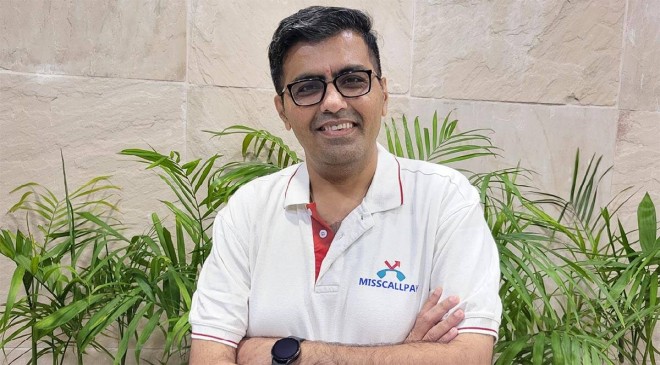What if you could make a payment using the UPI after giving a simple missed call? That’s what MissCallPay offers to India’s vast feature phone user base. The company has partnered with the Bank of India as the supporting bank to roll out the facility. “UPI is primarily for tech-savvy smartphone users. The total user on UPI today is barely 260 million. Almost 91 crore people today are aloof to the UPI revolution,” Mitesh L Thakker, Founder, MissCallPay, told indianexpress.com.
MissCallPay’s solution is built under the UPI123 system, which was announced earlier this year to bring more feature phone users under the United Payments Interface ambit.
With MissCallPay, a feature phone user can access their bank account, transfer funds, and make bill payments by simply giving a missed call to the number displayed at a merchant’s store. Once the user gives a missed call, they will immediately get a callback from MissCallPay, asking them to authenticate the transaction by entering their UPI PIN.
Read More: Central Bank of India (CBI) hikes fixed deposit interest rates; check return calculator
“The premise behind UPI123 Pay is that it should cater to a greater section of our Bharat. Users should be doing all transactions almost digitally, and that is the whole focus of the government,” Thakker added.
MissCallPay has worked closely with the National Payments Corporation of India (NPCI), which is the umbrella organisation responsible for services such as UPI Payment, Bharat Bill Pay, RuPay, etc.
Keeping languages in mind
But creating an IVR-based payment system for feature phones, especially with an emphasis on languages, was not without its challenges. As Thakker explained, applying the properties of a purely digital and internet-based channel, such as UPI, to a telephony channel was not easy.

In order to make payments on UPI, a user just needs to give a missed call to a number. (Image credit: MissCallPay)
The company also had to create a system that supports many regional Indian languages. For this, they chose to work with Reverie Language Technologies, a technology company that helps build products for regional Indian languages. “Earlier on, Reverie only had modules for the internet domain. They took the challenge and adapted that to lower bandwidth channels. Without languages, this cannot work. Reverie has developed 12 languages which can help us cover a great length and breadth of the country,” Thakker said.
Read More: Sundaram Finance to revise interest rates from Nov 16 – check new rates here!
MissCallPay will support 12 Indian languages, including Hindi, Marathi, Gujarati, Tamil, Telugu, Malayalam, Odia, Kannada, Assamese, English, Bengali, and Punjabi.
Arvind Pani, Co-Founder and CEO, Reverie Language Technologies, said the company had to specifically train its language models to work in narrowband for Interactive Voice Response (IVR) lines. “The fundamental aspect that we are trying to solve is how the solution becomes useful for end users who don’t prefer English. It needs to be easy to implement without compromising quality in terms of user experience,” Pani added.
For MissCallPay, Reverie used automation to record these IVR interfaces. “The big step in automation is that in IVR, everything prompted is actually not a human voice. But those are all machine-generated through our text-to-speech APIs,” Pani pointed out, adding that these come at a significantly lower cost compared to typical IVRs, which need to be recorded in the studio.
Capturing bank names accurately
The companies also had to remember that the system accurately captures the user’s details, such as the bank name, and preferred language. One challenge here was that across India, there tend to be variations in how people use a bank’s name. For instance, some might say SBI for the State Bank of India, while others could just say State Bank. The system had to be dynamic enough to understand that the user means the State Bank of India, no matter the variation in the name.
“There are some banks named Shamrao Mittal Cooperative Bank. Some people will only call it Shamrao bank. Some will call it an SMB bank. Further, dialect also changes in India every 30-40 km. So, the engine has to be that sophisticated to understand and decipher what is being said,” Thakker pointed. He added that the other aim is to ensure that the payment takes place quickly, in a matter of seconds, so the interface must be simple.
Regarding safety, Thakker said MissCallPay is essentially a kind of phone banking and not as easy to compromise. He also pointed out that when a user gives a missed call, they get a call back from the service in 10 seconds, which is harder to spoof. “Hackers cannot trace your missed call, and they cannot know your preferred language or name. You give a missed call and get a call back in your own local language that you prefer. So if you’re travelling in Tamil Nadu and your language is set as Marathi, you will not get a call back in Tamil,” he added.
Thakker said the service has seen a great response so far. Of course, it will also need wide adoption from merchants before it becomes more mainstream. In his view, giving missed calls in the past was a habit that came easily to many Indians. But their platform could ensure it becomes a new way of making payments.





































